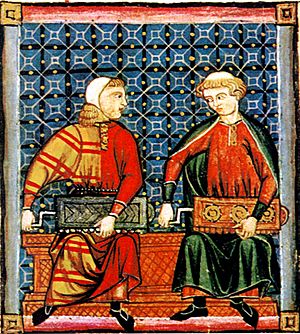Galician-Portuguese lyric facts for kids
In the Middle Ages, the Galician-Portuguese lyric was a special type of lyric poetry or song movement. It is also known as trovadorismo in Portugal and trobadorismo in Galicia. This movement created about 1680 poems and songs.
At that time, Galician-Portuguese was the main language for lyric poetry across most of Iberia. This old language is the ancestor of both modern Galician and Portuguese. The movement started around the late 1100s and lasted until the mid-1300s. It was very popular in the mid-1200s, especially with Alfonso X, also known as The Wise King.
This was the first known poetic movement in Galicia and Portugal. It marks the beginning of their poetic history and is considered a high point in poetry for both regions and for Medieval Europe.
Contents
What is Galician-Portuguese Lyric?
The Galician-Portuguese lyric was a style of poetry that was meant to be sung. It was popular in the Middle Ages, from the late 1100s to the mid-1300s. This type of poetry was written in the Galician-Portuguese language. This old language later developed into the modern Galician and Portuguese languages.
Who Were the Troubadours?
The poets of this movement were called troubadours. They were different from the Occitan troubadours, who wrote in a different language. Galician-Portuguese troubadours wrote almost entirely cantigas, which are types of songs.
These songs usually had a single melody, meaning they were monophonic. Only a few of these old melodies have survived today. They are found in two special old documents: the Pergaminho Vindel and the Pergaminho Sharrer.
The troubadours' poetry was made to be sung. However, they saw themselves as different from jograes. Jograes were performers who sang but usually did not write the songs themselves.
Collecting the Songs: Cancioneiros
Around the mid-1200s, these songs, also called cantares or trovas, began to be gathered into collections. These collections were known as cancioneiros, which means songbooks.
We know of three main songbooks from that time:
- The Cancioneiro da Ajuda
- The Cancioneiro Colocci-Brancuti (also called Cancioneiro da Biblioteca Nacional de Lisboa)
- The Cancioneiro da Vaticana
There is also another very important collection. It contains over 400 Galician-Portuguese cantigas and is called the Cantigas de Santa Maria. People believe that King Alfonso X, The Wise King, was involved in creating this collection. In his court, Galician-Portuguese was the main language for lyric poetry.
Types of Cantigas
The Galician-Portuguese cantigas can be divided into three main types. All of them were songs, often with musical instruments like stringed instruments. They also had some dramatic parts, like little plays.
Love Songs: Cantigas de Amor
These songs are called cantigas de amor. They are love poems sung from a male point of view. They often talk about a knight or a man expressing his love for a lady. The style of these songs was somewhat influenced by love poetry from other parts of Europe.
Friend Songs: Cantigas de Amigo
These songs are called cantigas de amigo. They are love poems sung from a female point of view. The word "amigo" here means "lover" or "boyfriend." These songs often feature a girl talking to her mother or friends about her love. Many experts believe these songs came from local traditions in the region.
Funny and Insulting Songs: Cantigas d'Escarnho e de Mal Dizer
These songs are called cantigas d'escarnho e de mal dizer. They are poems of insult and mockery. They could be funny, making fun of people or situations. Sometimes they were more direct and insulting. These two types of songs, cantigas de amigo and cantigas d'escarnho e de mal dizer, are quite special. They make the Galician-Portuguese lyric unique among medieval European poetry.
See also
 In Spanish: Lírica galaicoportuguesa para niños
In Spanish: Lírica galaicoportuguesa para niños
- List of Galician-Portuguese troubadours
- Cantiga de amigo
- Cantiga de amor
- Cantigas de escárnio e maldizer



